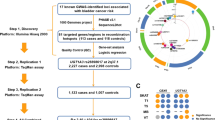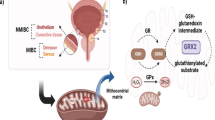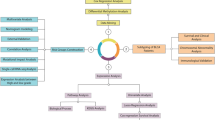Abstract
Urinary bladder cancer (UBC) is a common cancer with male predominance. Pathologically it is classified into two distinct tumor entities related to the risk of patients. The low-grade tumors with relatively well-differentiated tumor histology (G1 and G2) at stage Ta are non-invasive and pose a minimal risk, whereas high-grade tumors (G2 and G3) with stages T1 to T4 are aggressive with invasion, and therefore, pose a serious risk for the patients. DNA repair and metabolic process genes may have major roles in cancer progression and development. To identify genes associated with invasiveness of UBC, we have extensively genotyped 802 single nucleotide polymorphisms in 114 genes related to DNA repair mechanisms and metabolic processes. A genetic association study was performed between non-invasive (G1 and G2 with Ta) and invasive (G2 and G3 with T1 to T4) groups of Japanese UBC patients. We found that rs17650301 in POLG2 showed marked difference in genotype distribution between the two groups in males (P=6.93 × 10−4), which was further confirmed in an independent sample set (overall P=1.67 × 10−4). We also found by an in silico analysis that the risk allele of rs17650301 increased the transcription of POLG2. In conclusion, rs17650301 is a good candidate marker for UBC invasiveness in Japanese males.
Similar content being viewed by others
Log in or create a free account to read this content
Gain free access to this article, as well as selected content from this journal and more on nature.com
or
References
Greene, F. L., Compton, C. C., Fritz, A. G., Shah, J. & Winchester, D. P. AJCC Cancer Staging Atlas (Springer, New York, 2006).
Meiden, A.v.d. in Invasive Bladder Cancer (eds Bassi, P. & Pagano, F.) 67–76 (Springer, London, 2007).
Gofrit, O. N., Pode, D., Lazar, A., Katz, R. & Shapiro, A. Watchful waiting policy in recurrent Ta G1 bladder tumors. Eur. Urol. 49, 303–306 discussion 306-307 (2006).
McNally, M. L., Rashid, H. H. & Messing, E. M. in Invasive Bladder Cancer (eds Bassi, P. & Pagano, F.) 15–38 (Springer, London, 2007).
Taylor, J. A., Umbach, D. M., Stephens, E., Castranio, T., Paulson, D., Robertson, C. et al. The role of N-acetylation polymorphisms in smoking-associated bladder cancer: evidence of a gene-gene-exposure three-way interaction. Cancer Res. 58, 3603–3610 (1998).
Sanyal, S., Festa, F., Sakano, S., Zhang, Z., Steineck, G., Norming, U. et al. Polymorphisms in DNA repair and metabolic genes in bladder cancer. Carcinogenesis 25, 729–734 (2004).
Garcia-Closas, M., Malats, N., Silverman, D., Dosemeci, M., Kogevinas, M., Hein, D. W. et al. NAT2 slow acetylation, GSTM1 null genotype, and risk of bladder cancer: results from the Spanish Bladder Cancer Study and meta-analyses. Lancet 366, 649–659 (2005).
Figueroa, J. D., Malats, N., Rothman, N., Real, F. X., Silverman, D., Kogevinas, M. et al. Evaluation of genetic variation in the double-strand break repair pathway and bladder cancer risk. Carcinogenesis 28, 1788–1793 (2007).
Danoy, P., Sonoda, E., Lathrop, M., Takeda, S. & Matsuda, F. A naturally occurring genetic variant of human XRCC2 (R188H) confers increased resistance to cisplatin-induced DNA damage. Biochem. Biophys. Res. Commun. 352, 763–768 (2007).
Takahashi, M., Matsuda, F., Margetic, N. & Lathrop, M. Automated identification of single nucleotide polymorphisms from sequencing data. J. Bioinform. Comput. Biol. 1, 253–265 (2003).
The International HapMap Consortium. A haplotype map of the human genome. Nature 437, 1299–1320 (2005).
Purcell, S., Neale, B., Todd-Brown, K., Thomas, L., Ferreira, M. A., Bender, D. et al. PLINK: a tool set for whole-genome association and population-based linkage analyses. Am. J. Hum. Genet. 81, 559–575 (2007).
Breslowk, N. E. & Day, N. E. Statistical methods in cancer research. Volume I—The analysis of case-control studies. IARC Sci. Publ. 5–338 (1980).
Stranger, B. E., Forrest, M. S., Dunning, M., Ingle, C. E., Beazley, C., Thorne, N. et al. Relative impact of nucleotide and copy number variation on gene expression phenotypes. Science 315, 848–853 (2007).
Portales-Casamar, E., Thongjuea, S., Kwon, A. T., Arenillas, D., Zhao, X., Valen, E. et al. JASPAR 2010: the greatly expanded open-access database of transcription factor binding profiles. Nucleic Acids Res. 38, D105–D110 (2010).
Lim, S. E., Longley, M. J. & Copeland, W. C. The mitochondrial p55 accessory subunit of human DNA polymerase gamma enhances DNA binding, promotes processive DNA synthesis, and confers N-ethylmaleimide resistance. J. Biol. Chem. 274, 38197–38203 (1999).
Yakubovskaya, E., Chen, Z., Carrodeguas, J. A., Kisker, C. & Bogenhagen, D. F. Functional human mitochondrial DNA polymerase gamma forms a heterotrimer. J. Biol. Chem. 281, 374–382 (2006).
Michiels, S., Danoy, P., Dessen, P., Bera, A., Boulet, T., Bouchardy, C. et al. Polymorphism discovery in 62 DNA repair genes and haplotype associations with risks for lung and head and neck cancers. Carcinogenesis 28, 1731–1739 (2007).
Miyamoto, H., Yang, Z., Chen, Y. T., Ishiguro, H., Uemura, H., Kubota, Y. et al. Promotion of bladder cancer development and progression by androgen receptor signals. J. Natl. Cancer Inst. 99, 558–568 (2007).
McGrath, M., Michaud, D. S. & De Vivo, I. Hormonal and reproductive factors and the risk of bladder cancer in women. Am. J. Epidemiol. 163, 236–244 (2006).
Zeegers, M. P., Tan, F. E., Dorant, E. & van Den Brandt, P. A. The impact of characteristics of cigarette smoking on urinary tract cancer risk: a meta-analysis of epidemiologic studies. Cancer 89, 630–639 (2000).
Puente, D., Hartge, P., Greiser, E., Cantor, K. P., King, W. D., Gonzalez, C. A. et al. A pooled analysis of bladder cancer case-control studies evaluating smoking in men and women. Cancer Causes Control 17, 71–79 (2006).
Acknowledgements
We would like to express our gratitude to all the study participants who made this research possible. We also thank M Kokubo and M Mizutani for technical assistance, and A Yoshizumi and H Uneme for informatics management. This study was supported, in part, by Core Research of Evolutional Science & Technology program (CREST) from Japan Science and Technology Agency (JST) and by Institut National de la Santé et de la Racherche Médicale.
Author information
Authors and Affiliations
Corresponding author
Additional information
Supplementary Information accompanies the paper on Journal of Human Genetics website
Supplementary information
Rights and permissions
About this article
Cite this article
Ratanajaraya, C., Nishiyama, H., Takahashi, M. et al. A polymorphism of the POLG2 gene is genetically associated with the invasiveness of urinary bladder cancer in Japanese males. J Hum Genet 56, 572–576 (2011). https://doi.org/10.1038/jhg.2011.60
Received:
Revised:
Accepted:
Published:
Issue date:
DOI: https://doi.org/10.1038/jhg.2011.60
Keywords
This article is cited by
-
Spotlight on the relevance of mtDNA in cancer
Clinical and Translational Oncology (2017)
-
Urinzytologie – Update 2013
Der Urologe (2013)
-
Association studies getting broader: A commentary on A polymorphism of the POLG2 gene is genetically associated with the invasiveness of urinary bladder cancer in Japanese males
Journal of Human Genetics (2011)



